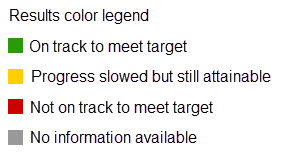City Employee Safety - Total Recordable Injury Rate (TRIR) YTD
Desired Result: Below Target

Analysis of Performance
Note: This historical data of this metric changes in subsequent time periods because injury data is tied to the date of injury regardless of when treatment occurs or the case changes from recordable to time away restricted, or transferred. For example, if an employee has an injury in March but he does not seek medical treatment until June, it will be captured on March's OSHA log and it will not show up on the June log. There is an approximate 18 month lag time in current available national benchmark data from the Bureau of Labor Statistics.
Although the City has seen an increase in injuries—some specifically related to summer hazards such as insect stings and extreme heat—the number of severe injuries has declined. This is likely due to improved staff training and higher employee retention, which have contributed to quicker, more effective responses to incidents and supervisor intervention for early treatment.
We are working with departments to include appropriate PPE in their annual budget proposals to align with identified job hazards. Safety specialists are also working to identify a standardized list of approved PPE for cost management benefits.
Metric Definition
The Total Recordable Injury Rate (TRIR) is a nationally recognized standard safety metric. It is based upon the total number of work related injury and illness cases reported that, generally speaking, required more than standard first aid treatment, as it relates to the total number of employee hours worked. Current-year benchmarks are not available as they are published by the Bureau of Labor Statistics and have an approximate 18 month lag time.
Why Is This Important?
The Total Recordable Injury Rate (TRIR) is important because it is a nationally benchmarkeable measure that allows us to track injury frequency trends over time. It is important for the City to provide a safe workplace for all employees and the only way to achieve that is by driving a culture of proactive safety built on continuous improvement. As safety efforts drive down injuries, the costs associated with workers' compensation claims can be driven down as well. While the TRIR is a lagging indicator, it is valuable as a symptom of the effectiveness of our proactive injury prevention efforts.
City Organization Impact on Performance
High – Reducing the TRIR rate requires the City to reduce the number of injuries that are sustained in any given year. Driving down injuries requires workgroups to actively work to identify and mitigate injury causes. We are seeing more employee involvement throughout the City now than at any point in the past through sharing of best practices and lessons learned, excellent active safety meeting attendance, new safety teams being launched, and safety team members being called on more than ever by their workgroups to help spearhead safety improvements.
Benchmark Information
This metric contains General Industry and Public Entities benchmark data. The General Industry benchmark gives overall context to the City's performance, while the Public Entities benchmark allows for a closer comparison that accounts for the unique challenges that face local governments.